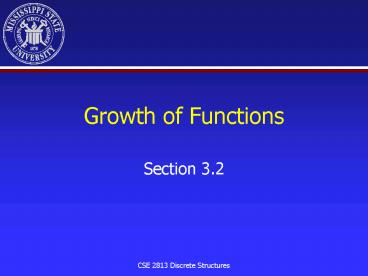Growth of Functions - PowerPoint PPT Presentation
1 / 29
Title:
Growth of Functions
Description:
Measuring Runtimes. Benchmarking - Code and run algorithm and measure running time ... Analysis determines the runtime of an algorithm based on the input size ... – PowerPoint PPT presentation
Number of Views:61
Avg rating:3.0/5.0
Title: Growth of Functions
1
Growth of Functions
- Section 3.2
2
Algorithm
- Any well-defined computational procedure that
takes some value or set of values as input and
produces some value or set of values as output.
3
Factors to be considered for choosing an algorithm
- Simplicity - Easy to implement and obviously
correct - Clarity - Easy to read and to maintain
- Extensibility - Can easily be extended to new
tasks - Reusability - Can be adapted to different tasks
- Efficiency - Uses time and space well
4
Measuring Runtimes
- Benchmarking - Code and run algorithm and measure
running time - Requires implementation
- Need to run a variety of typical inputs
- Need to make sure that comparisons are done only
across comparable platforms
5
Analysis
- Analysis determines the runtime of an algorithm
based on the input size - Gives you the relative rate of growth but not
specific time/space of execution - Allows for comparison of algorithms without
implementation - Not hardware specific
- Describes the number of operations for a given
input size, or the space required.
6
What is Input Size?
- Depends on the problem being analyzed
- The number of items in the input is often used
- Number of values in a sorting algorithm
- May use more than one parameter
- Number of edges and vertices in a graph
- Number of columns and rows in a matrix
7
Asymptotic notations
- Asymptotic efficiency of algorithms
- How does the running time of an algorithm
increase as the input increases in size without
bound? - Asymptotic notations
- Define sets of functions that satisfy certain
criteria and use these to characterize time and
space complexity of algorithms
8
Big-O
- Let f and g be functions from N or R to R. We say
that f(x) is O(g(x)) if there are positive
constants C and k such that - f(x) ? Cg(x)
- whenever x gt k.
- Read as f(x) is big-oh of g(x)
9
Big-O
C g(x)
f(x)
g(x)
x
k
10
Big-O
- Big-O provides an upper bound on a function (to
within a constant factor) - O(g(x)) is a set of functions
- Commonly used notation
- f(x) O(g(x))
- Correct notation
- f(x) ? O(g(x))
- Meaningless statement
- O(g(x)) f(x)
11
Example
- Show that x22x1 is O(x2).
12
Example
- Show that 2x33x21 is O(x3).
13
Example
- Show that 7x2 is O(x3).
14
Properties of Big-O
- If f(x) is O(g(x)) then g(x) grows at least as
fast as f(x) - f(x) is O(g(x)) iff O(f(x)) ? O(g(x))
- If f(x) is O(g(x)) and g(x) is O(f(x)) then
- O(f(x))O(g(x))
- If f(x) is O(g(x)) and h(x) is O(g(x)) then
- (fh)(x) is O(g(x))
15
Properties of Big-O (Cont..)
- If a is a scalar and f(x) is O(g(x)), then
- af(x) is O(g(x))
- If f(x) is O(g(x)) and g(x) is O(h(x)), then
- f(x) is O(h(x))
- f(x) O(g(x))
- In practice, g(x) is chosen to be as small as
possible
16
Common Complexity Functions
Complexity Term O(1) constant O(log
n) logarithmic O(n) linear O(n log
n) n log n O(nb) polynomial O(bn) b gt
1 exponential O(n!) factorial
17
Growth of Some Common Functions
18
Important Big-O Result
- Let f(x)anxnan-1xn-1a1xa0, where a0, a1,
,an-1, an are real numbers. Then f(x) is O(xn).
19
Big-O Estimates
- What is the big-O estimate for n!?
n! ? 1 2 3 n
? n! ? n n n n
? n! ? nn
n! is O(nn)
- What is the big-O estimate for log(n!)?
n! ? nn
? log n! ? log nn
log n! is O(n log n)
? log n! ? n log n
20
Growth of Combinations of Functions
- Addition of functions
- If f1(x) is O(g1(x)) and f2(x) is
O(g2(x)), - then (f1 f2)(x) is
O(max(g1(x),g2(x))). - Example What is the complexity of the function
n2 log(n!) ?
21
Growth of Combinations of Functions
- Multiplication of functions
- If f1(x) is O(g1(x)) and f2(x) is
O(g2(x)), - then (f1f2)(x) is O(g1(x)g2(x)).
- Example What is the complexity of the function
3nlog(n!) ?
22
Big-Omega
- f(x)O(g(x)) only provides an upper bound in
terms of g(x) for f(x). - What do we do for a lower bound?
- Big-Omega provides a lower bound for a function
to within a constant factor.
23
Big-Omega
- Let f and g be functions from N or R to R. We say
that f(x) is ?(g(x)) if there are positive
constants C and k such that - f(x) ? C g(x)
- whenever x gt k.
- Read as f(x) is big-Omega of g(x)
24
Big-Omega
f(x)
Cg(x)
g(x)
x
k
25
Example
- Show that 8x35x27 is ?(x3).
26
Big-Theta
- f(x)O(g(x)) only provides an upper bound in
terms of g(x) for f(x). - f(x)?(g(x)) only provides a lower bound in terms
of g(x) for f(x). - Big-Theta provides both an upper bound and a
lower bound for a function in terms of a
reference function g(x)
27
Big-Theta
- Let f and g be functions from N or R to R. We say
that f(x) is ?(g(x)) if f(x) is O(g(x)) and
f(x) is ?(g(x)), i.e., there are positive
constants C1, C2, and k such that - C1g(x) ? f(x) ? C2g(x)
- whenever xgtk.
- Read as f(x) is big-Theta of g(x)
- f(x) is of order g(x)
28
Big-Theta
C2g(x)
f(x)
C1g(x)
x
k
29
Example
- Show that 3x28xlogx is ?(x2).































